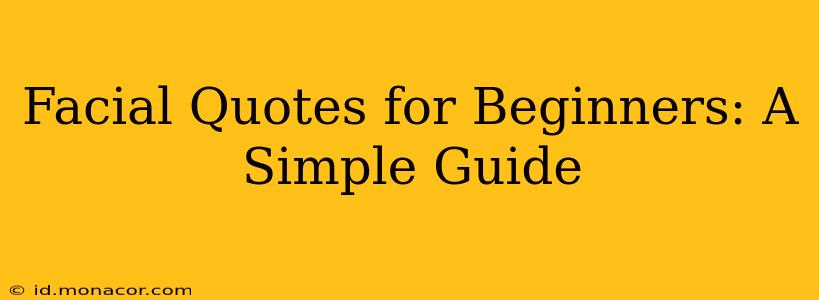Learning to quote faces accurately and effectively is a fundamental skill for artists, animators, and anyone working with character design or illustration. This beginner's guide provides a simple, step-by-step approach to understanding and mastering facial quotes, focusing on clear explanations and practical applications. We’ll move beyond just mimicking expressions and delve into the underlying anatomy and emotional impact of facial features.
What are Facial Quotes?
Facial quotes refer to the subtle and expressive movements of facial muscles that convey emotion, personality, and intent. They're not about perfectly replicating a photograph; instead, they are about capturing the essence of an expression using simplified, yet effective, techniques. Think of it as a shorthand for emotion, a quick way to tell a story with a face. Mastering facial quotes allows you to create believable and engaging characters regardless of your artistic style.
Understanding Basic Facial Anatomy for Accurate Quotes
Before diving into specific expressions, understanding the basic anatomy of the face is crucial. Key areas to focus on include:
- Eyes: The eyes are the most expressive part of the face. Consider the shape of the eyes (almond, round, etc.), the eyebrows' position and shape, and the size and direction of the pupils. Slight changes in these areas can drastically alter the perceived emotion.
- Mouth: The mouth's shape and position are also vital. A simple curve can indicate happiness, a downturned line sadness, and a tight line anger or determination. The position of the jawline also plays a significant role.
- Nose: While often overlooked, the nose can subtly contribute to the overall expression. For example, a slightly flared nostril can suggest excitement or exertion.
- Cheeks: The cheeks can puff out to indicate emotions like happiness or anger and hollow to suggest sadness or exhaustion.
How to Practice Facial Quotes: A Step-by-Step Guide
-
Start with Simple Expressions: Begin by practicing basic emotions like happiness, sadness, anger, and surprise. Focus on exaggerating these expressions initially to understand the key muscle movements involved.
-
Use Reference Images: Use photographs or videos of people displaying different expressions as references. Pay close attention to the subtle changes in the features described above.
-
Break Down Expressions: Deconstruct each expression into its component parts. What is the shape of the mouth? Where are the eyebrows? What's happening with the eyes? Understanding these elements allows for more controlled and accurate representation.
-
Practice Sketching: Practice sketching these expressions repeatedly. Start with simple line drawings, focusing on the key features and their movements. Gradually add more detail as you gain confidence.
-
Experiment with Style: Once you feel comfortable with realistic depictions, try simplifying your style. Cartoonish or stylized characters often use exaggerated facial quotes to amplify their emotional impact.
How do I create believable facial expressions in my drawings?
Creating believable facial expressions hinges on understanding the underlying anatomy and how muscles interact to produce various emotions. Use reference images, study expressions in real life, and practice regularly to develop your observational skills and ability to translate these observations into your art. Remember to consider the context of the scene; the expression should complement the narrative.
What are the common mistakes beginners make when drawing facial expressions?
Common mistakes include: ignoring subtle changes in the eyes and mouth, focusing too much on details without understanding the underlying structure, and lacking understanding of how light and shadow affect the perception of expressions. Regular practice and feedback are key to overcoming these challenges.
How can I improve my ability to draw realistic facial quotes?
Focus on improving your observational skills. Practice drawing from life, paying close attention to the subtle changes in facial muscles. Use anatomy references to guide your understanding of the underlying structure. Seek feedback from others and constantly practice to refine your technique. Study the work of master artists for inspiration and to learn from their techniques.
What are some good resources for learning more about facial expressions?
Numerous resources are available online, including tutorials, anatomy guides, and reference photographs. Search for "facial anatomy for artists" or "drawing facial expressions" to find numerous helpful resources. Books on figure drawing and character design are also valuable learning tools.
By following these steps and practicing consistently, you'll significantly improve your ability to quote faces effectively, bringing your characters to life with believable and engaging expressions. Remember, practice makes perfect—the more you experiment, the better you'll become at capturing the nuances of human emotion through facial expressions.

